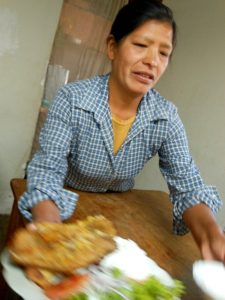The Heart of Cuzco’s Traditional Cuisine Lives in the Picantería El Secreto Sanbleño

The classical, traditional restaurants of Cuzco are the picanterías. They still enshrine that is both typical of the region and the picantería, at the same time they are an entire cultural experience. Nevertheless, like all the rest of Cuzco they are changing rapidly.
Not too many decades ago, when the famous Picantería La Chola ruled in Cuzco, to enter a picantería was to enter a place with smoke up above from the fogón, the traditional wood fired stove, often a dirt floor, and long shared benches not unlike picnic benches. The food was abundant, flavorful, and while eating, you often would share random conversation with others at your table.
Despite a long history in Cuzco, La Chola closed its doors, though its memory and romanticism remains, along with the classic image of the Cuzco’s cholita, a woman dressed in her broad skirts, white blouse, apron and the ever present white stove pipe hat with a broad, colorful ribbon over her two braids.
Increasingly working women dress in more international and industrial clothing, and the picantería has evolved. One of the current manifestations of this tradition is the Secreto Sanbleño, whose name translates as the San Blas Secret. A secret it is, because it is down a narrow, dead end street behind San Blas Market in the Chiwanpata neighborhood of craftsmen. It has no big sign out in front announcing it, just as La Chola had none. You just have to know it is there and when it is open. But to the people of this neighborhood very close to the main square it is a classic and very much living.
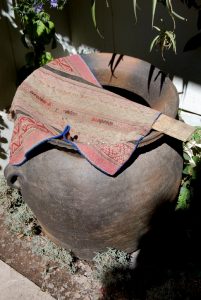
In the days of La Chola travelers who arrived in Cuzco by bus would be told by fellows that if you wanted the best food that was redolent of the town and its real life, you did not go to the tourist restaurants, fine or otherwise, Instead you made your way to the Picantería La Chola. It was not far from the Plaza but it was rustic and local.

Nowadays, Cuzco has excellent chefs who have come and important restauranteurs, such as the internationally renowned Gastón Acurio and Coque Ossio, have opened good restaurants in the city. The quality of the tourist fare has improved and its finest fits in the gastronomic offerings of the world’s quality restaurants. Kids from Cuzco are flocking to culinary schools, and Novo-Andean cuisine presents reformed variations of Andean standards and ingredients. But to know the soul of Cuzco, or the Andes in general, you need to go to a picantería, and Secreto Sanbleño is one of the most authentic.
This is not a picantería scrubbed and refashioned into a modern food venue, but has rustic wooden floors and wooden tables where over time people have carved their initials, loves, and comments. Its walls are painted plaster and have beer posters and saints on them as decorations and invocations of the holy.

It fills with people from the neighborhood, those who work nearby, and a few tourists. Locals know the quality of the food it serves and they appreciate its authenticity. They also enjoy the music it has playing on its speakers; this is the popular music of the day in Cuzco, including a range of bouncy, happy huaynos.
To order you food, you take a seat and look at the board where the days offerings of dishes are written. Usually almost immediately after you have entered and take a seat a woman or man will appear and give you a slip of paper on which you can write what you wish to have that day. This is not a place where they bring you long and involved menus, more like dreams than actual offerings. Then the server will return and take your paper.
The servers are not people in uniforms trained in institutes about how to pour a glass of wine or take down orders. They are just ordinary people from Cuzco, the kind of ordinariness that used to be contained in the name “La Chola”. They will only take you note, bring you your food, and leave you alone to enjoy your meal while they work in the at preparing food or some other task. Then they will take your money when you leave. It is always wise to have close to exact change since they do not keep lots of money on hand.
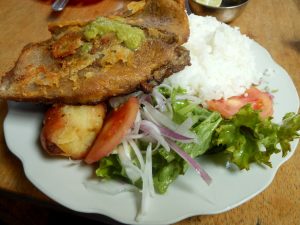
The Secreto Sanbleño offers a provocative list of traditional dishes on a small blackboard. These include pernil al horno (oven baked pork loin), ubre apanada (breaded cow’s udder), pollo al horno (oven baked chicken), tripa frita (fried tripe), montado (a beef loin steak with a fried egg on top), caldos (soups), churrasco al jugo (grilled meat au jus), lengua atomatada (tomatoed beef tongue), malaya frita (fried malaya–a local beef cut), corazón (beef heart), and others.
Almost immediately after they take your order of a main dish, the server will bring you a bowl of soup. Generally this is the soup of the day, such as a concentration made from boiled meat and vegetables. Sometimes they may seem strong for the palate of someone who is not from Cuzco. But it is our tradition for them to be strong. These broths are the favorites of the people of Cuzco. Generally the soup comes with a little rice or minced herbs, called asnapa, to give it additional flavor, as well as a quarter lime and some hot sauce (uchukuta).
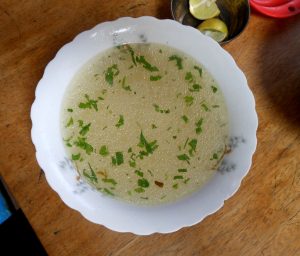
People worry that the traditional picanterías are loosing their customs and their particular details that give them character and make them special. Little by little the techniques or preparing the food are changing as culinary training replaces the empirical style learned by the cooks and passed down generations. At the same time the traditions of attention and service are also changing as the many institutes attempt to bring world-class norms and styles to Cuzco’s restaurants. But this also means a loss of locale, terroir as they call it, and culture.
An example of changed techniques. It used to be that the uchukuta (hot sauce) was made by hand grinding the ingredients between stones (the batán) but nowadays most people use a blender. It used to be that all cooking was done on the traditional wood fired stoves and ovens, fogones and hornos), though now many places use modern, gas stoves and ovens. Even though the changes subtly change the food,t he textures and taste no longer are the same, nevertheless it is difficult to resist the changes as time advances.
After “opening” our appetite with the concentrated broth, the main dishes arrive. When I went last I asked for fried mutton ribs (costillar frito). It is one of my favorite dishes and has great taste. I had been taking some pictures to accompany this article and when I put down the camera and tasted my meal I was left surprised and almost without words. In myself I asked how can it be that in a place so hidden and one that does not put its attractions out on the street to call attention to itself could one find such fantastic food.
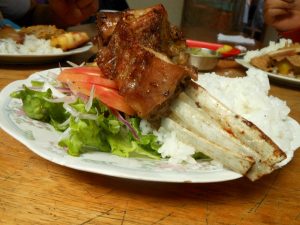
The Secreto Sanbleño is an example of the kinds of places we Peruvians just call huariques. With their simple wooden tables and floors, traditional music, an even a fly or two, they are seem hidden yet they are the heart of our culinary traditions. Far more so that the celebrity chefs.
The tender and very flavorful meat combined with a fluffy huayco potato and uchukuta kept for the moment the traditions of Cuzco alive. The woman who served us was very friendly and attentive although she mostly left us alone but she definitely invited us to return. The prices are far less than one pays in the tourist restaurants and yet here is the real Cuzco.
